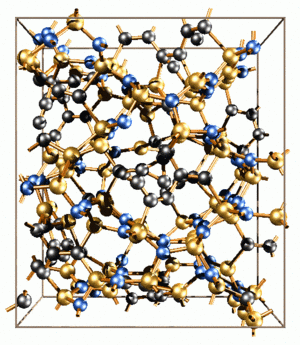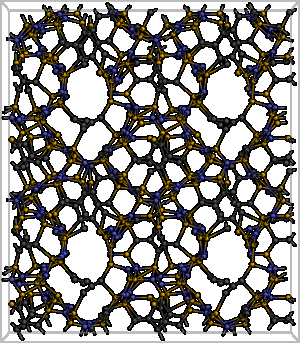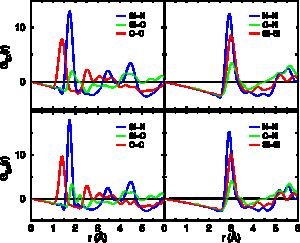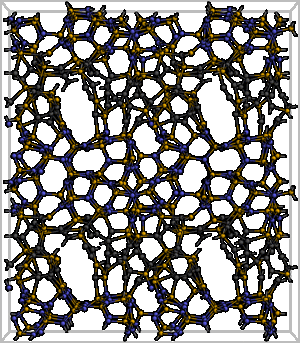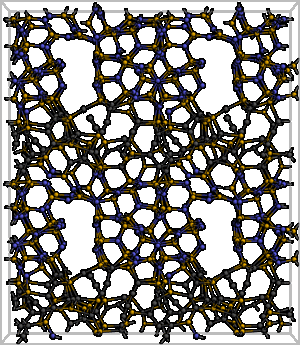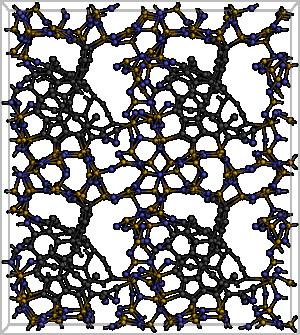Amorphous matter
- Amorphous precursor ceramics
- Amorphous SiCN films
Amorphous precursor ceramics
Since introduction of the polymer to ceramic conversion processing route, a lot of difficulties in ceramics production resulting from the former used sintering technique could be avoided. For sintering of ceramic powders, sintering aids had to be used to enhance densification. But because of the segregation of the sintering aids at the grain boundaries, these lead to pores or cracks in the material at higher temperatures together with a shrinkage of up to 15-20%. Instead, for the polymer-ceramic conversion, organometallic polymer precursors like polycarbosilane, -silazane, and -siloxane can be used to prepare ceramic components at low temperatures and without the addition of sintering aids by thermal induced composition (pyrolysis). Therefore, several plastic shaping technologies and laminated object manufacturing techniques can be applied to the preceramic polymers before pyrolysis, preventing expensive postprocessing steps of the final ceramic.
Figure1 : Amorphes Modell der Precursorkeramik Si37C32N31 mit Hohlräumen, hergestellt unter Verwendung des Precursors NCP200, eines Kopolymers aus Methyl- und Dimethylsilazaneinheiten im Verhältnis 2:1, welches häufig als polymere Vorstufe für die Herstellung von Keramiken verschiedenster Stöchiometrie verwendet wurde. Zur besseren Darstellung wurde das Modell in zwei Richtungen periodisch fortgesetzt (Si: gold, C: grau, N: blau).
With different precursors and varying pyrolysis regimes a wide range of amorphous ceramics with various compositions have been obtained, especially in the ternary phase diagram of Si-C-N. Amorphous ceramics produced in this way have high-temperature stability, strain and oxidation resistance and are used as coatings for tools, turbines or engines, and as ceramic fibers to reinforce ceramic matrix composites (CMC) in air- and spacecraft structures.
A variety of experimental techniques like X-ray and neutron diffraction, nuclear magnetic resonance (NMR), transmission electron microscopy (TEM) and electron spectroscopic imaging (ESI) have been applied to understand the polymer to ceramic conversion and to characterize the structure of the produced ceramics. This is necessary for the generation and understanding of the special high-temperature stability of the ceramics.
A variety of experimental techniques like X-ray and neutron diffraction, nuclear magnetic resonance (NMR), transmission electron microscopy (TEM) and electron spectroscopic imaging (ESI) have been applied to understand the polymer to ceramic conversion and to characterize the structure of the produced ceramics. This is necessary for the generation and understanding of the special high-temperature stability of the ceramics.
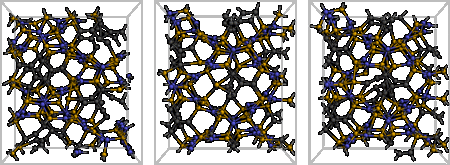
But in spite of these experimental efforts, the detailed atomic structure of these ceramics and so the exact relation between used precursor, pyrolysis regime, and resulting properties of the final ceramic material are still not well known. For example, it is still a question whether there is a homogeneous distribution of the carbon throughout the whole structure or if a separate amorphous carbon phase exists and of what kind the local environment of the different atom types is.
At this point, computer simulations at atomic level of these amorphous Si-C-N ceramics are highly desirable for their understanding because they are able to answer these questions delivering direct insight into the amorphous structure and providing correlations between structure and physical properties.
Figure5 : Amorphes Modell der Keramik Si41.4C23.2N35.4, hergestellt unter Verwendung des Precursors A5, einem copolymeren Silazan, welches aus Trichlorsilan und Methyldichlorsilan im Verhältnis n:m unter Entfernen von NH4Cl hergestellt wurde, und aus den beiden Komponenten [H-Si-(NH)1.5]n und [(H3C)(H)-Si-NH]m mit n=1 und m=2 besteht. Die Pyrolyse der Keramik wurde bei 1050 C durchgefuehrt. Zur besseren Darstellung wurde das Modell in zwei Richtungen periodisch fortgesetzt (Si: gold, C: grau, N: blau).
Our approach is the first density functional theory (DFT)-based molecular dynamics simulation of such a ternary ceramic system. In contrast to MDs with empirical potentials, here, the interatomic forces are calculated on a quantum mechanical basis without any constraints regarding coordination or bonding. Such a simulation becomes highly desirable to especially improve the atomic scale and local environment understanding of structure formation and related property correlations. In closely correlating the modeling and experimental efforts, the aim is to exactly tailor a ceramic material for a certain application just by choosing the right precursor and pyrolysis regime at the beginning.
Figure6 : Amorphes Modell der Keramik Si26.9C36.6N36.5. Diese Keramik wurde aus dem VT50-Precursor der Firma Höchst im Max-Planck-Institut für Metallforschung hergestellt. Dieser Poly(vinyl)silsesquiazan-Precursor besteht aus Polyvinylsilazan (PVS) und ca. 10% [N(CH3)2]n-Endgruppen. Zur besseren Darstellung wurde das Modell in zwei Richtungen periodisch fortgesetzt (Si: gold, C: grau, N: blau).
In our investigations, it could be shown that the precursor-derived amorphous ceramic definitely does not consist of a homogeneous distribution of atom types. Rather, a phase separation on atomic scale into amorphous Si3N4, amorphous SiC, and amorphous carbon exists in the final ceramic product. This is in good agreement with the experimental results and the position of this ceramic in the ternary phase diagram of Si-C-N between the quasibinary lines of Si3N4-C and Si3N4-SiC. We proposed possible model structures, all including the phase separation, but with different structural arrangements. One kind of models includes carbon clusters of 6 to 9 atoms forming ring-like structures, each surrounded by an amorphous SiC layer, which are embedded in the amorphous Si3N4 phase. Other models consists of a more chain-like layered amorphous carbon phase extended throughout the whole supercell structure with a small interface of SiC at the edges followed by amorphous Si3N4. This phase separation, in particular the formation of carbon clusters, is thaught to retard the crystallization process by hindering the thermal diffusion of the other atoms upon annealing and in this way to improve the temperature stability.
Amorphous SICN Films
The development of new materials or the modification of already known composites is a wide and important field of research in materials science and technology. For some purposes materials with versatile properties are needed, while other applications demand only a very specific behavior. Today, with the help of computer simulations, it is possible to estimate the physical and chemical properties of materials. As a result great efforts are being made to synthesize materials for which excellent properties can be predicted. Besides carbon nitrides the synthesis of materials containing silicon in addition to carbon and nitrogen has become of growing interest in recent years. To date several techniques have been developed to produce various kinds of Si-C-N composite (SiCxNy) films, which have excellent properties such as high oxidation resistance, wide band gap, and promising mechanical properties. Amorphous SiCxNy (a-SiCxNy) films synthesized by thermal chemical vapor deposition (CVD) techniques showed a hardness in the range of 27 GPa, while a-SiCxNy films deposited by electron cyclotron resonance (ECR) plasma CVD possessed a hardness of 22 GPa. For crystalline Si-C-N films produced by microwave plasma CVD a hardness of 30 GPa and a bulk modulus of 322 GPa were reported. Compared to the hardness predicted for the hypothetical b-C3N4, the values measured for the Si-C-N materials were much lower, although the addition of silicon was expected to promote the formation of sp3-hybridized carbons and also of additional bonds with nitrogen. In our research together with the Institute of Physical Chemistry at the University of Heidelberg, the Institute of Atomic and Molecular Sciences at the Academia Sinica in Taipei, the Center for Condensed Matter Sciences at the National Taiwan University in Taipei, and the Research Division, Synchrotron Radiation Research Center in Hsinchu, the proportions of Si, C, and N in the a-SiCxNy films deposited on silicon or fused silica substrates by ion beam sputtering (IBS) were varied systematically to investigate the elastic and mechanical properties as a function of the carbon content. Therefore, experimental techniques have been applied by the groups from Heidelberg and Taiwan and computer simulations were performed by us to study the structural and elastic properties of the a-SiCxNy films. Different models of the amorphous network were generated with varying carbon content and microscopic mass densities corresponding to the IBS deposited films. The composition of the experimentally deposited films was determined by X-ray photoelectron spectroscopy (XPS). Fourier transform infrared (FTIR) spectroscopy was applied to reveal the bonding configurations. Furthermore, surface acoustic wave spectroscopy (SAWS) was used to determine the Young's modulus and the density of the films. These experimental results were then compared with the Young's moduli and the IR spectra calculated from the model structures of our molecular dynamics simulations. Additionally, the network characteristics of the simulated structures were analyzed. This information is expected to improve the understanding of the dependence of the mechanical properties on the carbon content at the molecular level. It turned out that the increased incorporation of carbon reduces the Young's modulus and the density of the films. While the Young's modulus only slightly decreases for films with low carbon content, a significant reduction of the stiffness has been observed as the carbon content increases above 12%. This can be explained with the results of the FTIR and XPS spectra and the MD simulations, which indicate the appearance of C-C and C-N double bonds, and C-C and C-N triple bonds in the samples with higher carbon content. Thus, the observed variation in the elastic and mechanical properties can be attributed to an increasing fraction of these low-coordination bonds in the amorphous network that diminish the threedimensional connectivity and stiffness. These stronger bonds with higher bond order may also induce structural defects that reduce the density. In addition, the increasing proportion of terminating nitrogen atoms may cause small voids that further decrease the density.
Bremen Center for Computational Science | Universität Bremen| Otto-Hahn-Allee 1 | 28359 Bremen | Telephon: +49 (0)421-218- | Fax:
Geändert am: 03.07.2006

